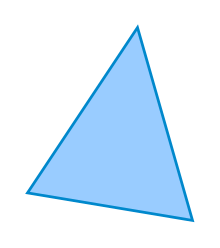Scalene triangle
| Triangle | |
|---|---|

A triangle
|
|
| Edges and vertices | 3 |
| Schläfli symbol | {3} (for equilateral) |
| Area | various methods; see below |
| Internal angle (degrees) | 60° (for equilateral) |
A triangle is a polygon with three edges and three vertices. It is one of the basic shapes in geometry. A triangle with vertices A, B, and C is denoted .
In Euclidean geometry any three points, when non-, determine a unique triangle and a unique plane (i.e. a two-dimensional Euclidean space). This article is about triangles in Euclidean geometry except where otherwise noted.
Triangles can be classified according to the lengths of their sides:
Hatch marks, also called tick marks, are used in diagrams of triangles and other geometric figures to identify sides of equal lengths. A side can be marked with a pattern of "ticks", short line segments in the form of tally marks; two sides have equal lengths if they are both marked with the same pattern. In a triangle, the pattern is usually no more than 3 ticks. An equilateral triangle has the same pattern on all 3 sides, an isosceles triangle has the same pattern on just 2 sides, and a scalene triangle has different patterns on all sides since no sides are equal. Similarly, patterns of 1, 2, or 3 concentric arcs inside the angles are used to indicate equal angles. An equilateral triangle has the same pattern on all 3 angles, an isosceles triangle has the same pattern on just 2 angles, and a scalene triangle has different patterns on all angles since no angles are equal.
Triangles can also be classified according to their internal angles, measured here in degrees.
...
Wikipedia

